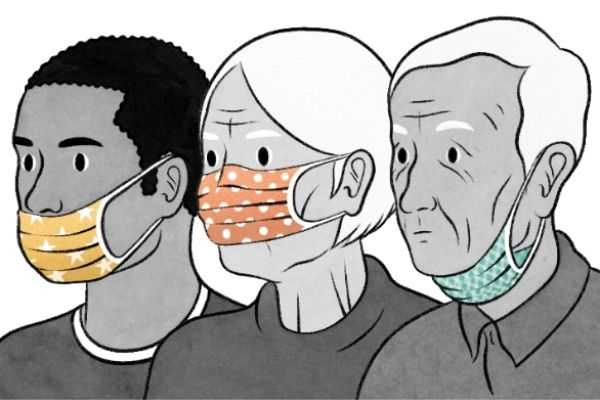
It’s time to un(mask) your dilemma
It’s that time of the day. You are getting ready to leave your house. You grab your car keys and are confident that you haven’t forgotten anything. You step into the elevator, and all of a sudden, panic strikes. You have forgotten your mask. You rush back but cannot shake the feeling that you will soon be light-headed, almost ready to pass out. The year 2020 introduced us to face masks. Majority of us find face masks to be an extremely uncomfortable layer of protection but have successfully adapted it as an extension of our life, a symbol of our times. We share a love-hate relationship with face masks. We don’t particularly find it comfortable, but we cannot live without it. Yet, there is a critical infodemic curve that we need to flatten.
Hypercapnia is a condition arising from increased levels of carbon dioxide in the blood. Its symptoms range from dizziness, drowsiness, fatigue, headache, shortness of breath, and disorientation to seizures, muscle twitching, loss of consciousness, and even coma. Undoubtedly, inhaling excessive amounts of carbon dioxide (C02) for prolonged periods is dangerous. Still, it is unlikely that you, as the general public, will suffer from these complications by wearing a mask. Does wearing a mask reduce oxygen supply? Widespread claims in the affirmative have been aggressively fueled by social media, but the World Health Organization has systematically issued statements to debunk this claim.
“CO2 will slowly build up in the mask over time. However, the level of CO2 likely to build up in the mask is mostly tolerable to people exposed to it. You might get a headache but you most likely [would] not suffer the symptoms observed at much higher levels of CO2” (Reuters, May 2020).
We understand that anxiety is real, and you might feel claustrophobic. However, the solution is not to get rid of masks entirely but to find a way around it. The side effects of wearing a mask can be combated as follows:
-
Foggy Glasses: Wash your glasses in soapy water, and leave them to air dry. This will form a film that prevents fogging. It would help if you also considered finding a mask that fits your face perfectly. Ensure the top of your mask is tight and the bottom loser to help direct exhaled breath away from the eyes.
-
Hygiene: Regularly launder, or machine dries your face mask depending on the frequency of use. Do not reuse a disposable mask and always change it as soon as it gets damp.
-
Skin Irritation: If you are prone to dry skin, be sure to moisturize before wearing a face mask. If you have sensitive skin, forgo make-up altogether since make-up can lead to decreased air filtration. Cleanse your face before and after wearing a face mask.
-
To control the rate of transmission of COVID-19, it, therefore, becomes each of our responsibility to advocate effectively wearing masks, dispense scientific evidence and adhere to suggested guidelines for the well-being of the community.
Read more: Can mosquitoes spread COVID-19 infection from one person to another?
Here are common misconceptions that you need to distance yourself from:
-
You do not need to wear a mask if you are not sick- Myth! Wearing a mask is preventative. Even if you have been administered the COVID-19 vaccine, it is recommended that you still wear a mask until you are certain that everyone around you has also been vaccinated. Evidence indicates that a significant section of the population does not have identifiable symptoms of COVID-19, increasing the chances of asymptomatic or pre-symptomatic transmission. Therefore, the simple act of wearing a face mask goes a long way in lowering the transmission of possibly infected respiratory droplets between people.
-
Cloth masks are not effective in protecting from COVID-19- False! A cloth-mask may not be as robust as an N-95 and may not completely prevent someone from acquiring the virus, but it helps contain it. This must be accompanied by social distancing, frequent hand-sanitization, and limited environmental exposure. Wearing a mask does not negate the requirement and necessity of these behaviours.
-
Masks can be made from any material as long as one’s face is covered: Alternatives are being offered in the market, such as mesh and lace masks. Their USP is based on the premise that they are more breathable. However, an open weave is inefficient in trapping large respiratory droplets from talking, coughing or sneezing, which serve as carriers of the infection.
-
You don’t have to wear a mask outside- This is only viable if the area outdoors is secluded and you are spending time with people you are currently living with. However, if there arises a need to travel to more crowded places where physical distancing is not possible, wearing a mask is unquestionable.
-
You must wear a mask while exercising- Considering that lockdown restrictions have been lifted and you can finally get back to your gym routines, you must have been wondering – is wearing a mask safe while exercising? It most definitely isn’t. Sweat can dampen your mask, making it difficult to breathe and promoting the growth of bacteria. The safest solution is to exercise indoors or practice social distancing religiously.
At the end of the day, prevention is better than cure. The perfect combination of awareness, compliance, and acceptance towards the proper wearing of a face mask is the first step to curtailing COVID-19 transmission.
Have a news story, an interesting write-up or simply a suggestion? Write to us at info@oneworldnews.com








